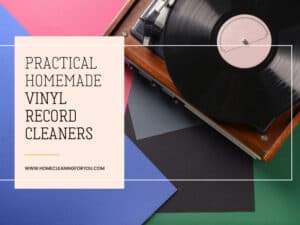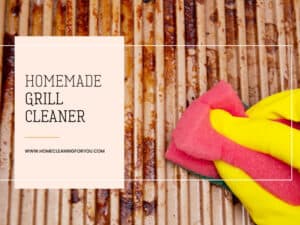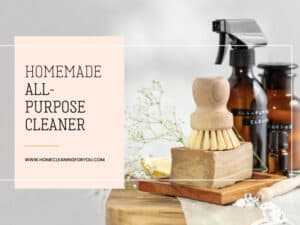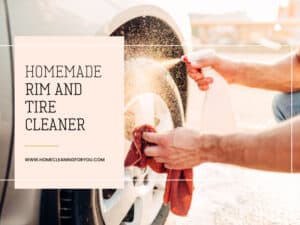Guide of DIY Ultrasonic Cleaner: Easy Solutions to Make Your Own
Homemade ultrasonic cleaners, tailored for your own needs, can deal with all your problems and satisfy all your demands.
Why do you pay a large amount of money for an ultrasonic cleaner and cleaning solutions while you can make them for yourself?
Cleaning rusty, dirty adhesive spare parts, machine details, and finding the best solvent now is not a big deal when you have this post in your hand. Well, I won’t lie to you. Let’s discover it right now.

What Is An Ultrasonic Cleaner. And How Does It Work?
The first thing you need to make an ultrasonic cleaner yourself is understanding what it is and how it is operated.
Ultrasonic Cleaner
An ultrasonic cleaner is a machine that helps you clean various objects by high-frequency sound. Every ultrasonic cleaner has three main components: a tank, a generator, and a transducer (1).

How Does An Ultrasonic Cleaner Work?
Here is the simple explanation for the working processes of an ultrasonic cleaner:
- To help the generator and transducer work, you need to plug the machine into the power supply. After turning on the cleaner, the transducer will vibrate and pulse. Thus, the electrical energy will be transformed into ultrasonic energy.
- The rapid movement of the transducer produces high-frequency compression sound waves. That creates cavitation bubbles (2). These bubbles move through the liquid and make the cleaning process start.
- These microscopic bubbles attack and remove contaminants.
The frequency of ultrasonic cleaning is measured in thousands of cycles per second. Most ultrasonic cleaners work around 40 to 60 kHz ( the frequency equivalent to 1,000 cycles per second).
Different levels of frequency will be used for various cleaning purposes. For example, tiny bubbles are produced at high frequency, which offers a gentler and more detailed cleaning action.
Meanwhile, the lower frequency will create more giant bubbles, serving more intense and aggressive cleaning actions.
Why Should You Make A DIY Ultrasonic Cleaner And Use Homemade Cleaning Solution?
A DIY Ultrasonic cleaner is the best alternative for a traditional one because it is more affordable and very easy to do.
Making homemade ultrasonic cleaners by using all-natural ingredients is such a wise option. By doing this, you can save your budget in the long run, protect yourself from toxins in commercial products, and protect the environment.
DIY Ultrasonic Cleaner
A homemade ultrasonic cleaner is a must-have item. Let’s consider fascinating reasons below:
- A homemade ultrasonic cleaner helps keep your equipment and all of its parts clean so that you can maintain or refurbish them for a longer time.
- A DIY ultrasonic cleaner is easy to make at home, with simple steps available on my post.
- An ultrasonic cleaner is very cost-effective. It ensures an efficient-reliable service throughout and saves you from wasting your time and money.
- Making this DIY item, in addition to helping you to clean all of your expensive jewelry or household items, makes you feel entertained and satisfied.
Homemade Cleaning Solution
There are various reasons why you should use a homemade cleaning solution instead of others sold on the market.
- DIY cleaning solutions are made of natural ingredients and cheaper than other kinds of detergents
- They’re easy to find because they are always available in your house.
The Easiest Way To Build A DIY Device
Building a homemade ultrasonic cleaner is not a complicated task, and it doesn’t require any skills or experience. Let’s see how simple a homemade ultrasonic cleaner is, and you can thoroughly make use of your household stuff.
What You Need:
- A coffee can
- Pail
- Palm sander
- Duct tape
- 2-inch thick foam
Instructions:
Step 1: Stick the foam under the bottom of the pail. The foam can absorb the vibrations. So, the pail will not move around once the palm sander and the coffee can vibrate.
Step 2: Turn on the palm sander. Remember not to plug it into the socket
Step 3: Tightly tap the palm sander to the bottom of the coffee can with duct tape.
Step 4: Fill the coffee can with liquid to about ¾ complete and put it into the pail.
Step 5: Plug the palm sander into the socket.
Step 6: The palm sander will produce heat after starting for several minutes. The warmth produced will be passed on to the coffee can.
The can will expand and shrink in high-temperature conditions. Then, the cavitation of bubbles will occur once the can becomes heated.
Step 7: Place your items in your DIY cleaner. You can turn off the palm sander whenever the coffee begins to expand and shrink.
If you want to make a DIY advanced ultrasonic cleaner, don’t miss this instruction.
Homemade Ultrasonic Cleaner-Effective Solutions
Ultrasonic cleaning solutions are essential in cleaning heavily soiled and dirty items. But they may cost a fortune.
So, why don’t you use homemade ultrasonic cleaners instead? Natural solutions are more affordable, and they are effective too.
For Jewelry
Jewelry such as bracelets, earrings, necklaces, helps you to have a good look, but they are also exposed to your sweat or oily skins every day. Therefore, regular cleaning is necessary to prevent your accessories from getting tarnished or dirty.
In this case, a jewelry cleaning solution will help a lot. Don’t have a cleaner on hand? Don’t worry; you can make one yourself. The recipe is made of all-natural ingredients that are always ready around your house.

What You Prepare:
- Water
- Household ammonia
- Mild detergent (dishwashing soap)
Instruction:
Step 1: Add two glasses of water into the tank.
Step 2: Mix a teaspoon of ammonia and 2 tablespoons of mild detergent with water and stir until the mixture dissolves completely.
Step 3: Turn on your cleaner device and leave it for 10 minutes. By doing this, the heavy smell of ammonia will be dissipated, and all ingredients will be blended thoroughly.
For Brass
Brass is easy to get dirt or tarnished when it is exposed to moisture or air. And brass items need to be cleaned more often. I’m sure that you wish to find a cleaner that is more affordable than commercial products.
Fortunately, here I have one. This is such a cheap, simple solution and will keep your brass shine.

What You Prepare:
- White vinegar
- Water
- Dish soap
Instruction:
Step 1: Mix 50% of white vinegar to 50% of water and some drops of dish soap
Step 2: Put your brass and the solvent into the cleaner
Step 3: Wait for 30 minutes and take your brass out.
A cheap and straightforward homemade ultrasonic cleaner for brass.
For Rust
Many household objects are prone to rust when they are exposed to moisture or air over time, from hammers, screwdrivers, to wrenches.
A perfect homemade ultrasonic cleaner will remove any rusted tools around your house. You only need to follow these easy steps to keep your items bright and shiny.

What You Prepare:
- White vinegar
- OxiClean
- Water
Instruction:
Step 1: Fill your ultrasonic cleaner with white vinegar, a half scoop of OxiClean, and water; make sure it is enough to cover all of your stuff. Then, warm up the cleaner
Step 2: Put your stuff into the tank and let them soak for a certain time. There should be an open space for the waves to do their jobs. Set the temperature.
Step 3: When the time cycle is done, take your stuff out. Dry them with towel paper or dry cloth. Slightly scrub the stuff with a brush if there is still some rust.
Essential Things You Need To Know When Using A Homemade Ultrasonic Cleaner
To maximize the efficiency of your ultrasonic cleaner, you should know helpful information and tips below.
How Often Should You Change The Cleaning Liquid?
Whenever you notice the used mixture is filthy, it can not provide a desirable result. It’s time to change into a fresh liquid solvent. To be ideal, you should change the cleaning fluids after 3-5 usages.
Also, make sure that you clean your ultrasonic bath before filling it with a new cleaning solution.
Cycle Time Of Ultrasonic Cleaners
The cycle times of ultrasonic cleaners are varied depending on many factors. Here are things that you should consider:
- The condition of the items: I mean, how dirty the thing is. The dirtier the thing is, the longer the cleaning time lasts.
- The number of parts or items being cleaned once: The more crowded a bath can be, the longer the cleaner will take to have an effective result.
- The frequency of your ultrasonic cleaner: Of course, the weak ultrasonic will make the cleaning cycle become longer. You can have a look at the below table for reference:
| Items need to be cleaned/ contaminants | Suggested time cycle ( minutes) |
| Motor engines | 40 |
| Printed Circuit Boards/solder flux | 3-10 |
| Highly Finished Parts/buffing compounds | 10 |
| Firearms/oils, powder residues/lead deposits | 10-12 |
| Carburetors/varnish, grease, and other deposits | 20 |
| Rusty Tools/rust | 15-30 |
| Injection Molds/burned on residues, oil, flashings | 10-15 or more |
| Dental Instruments/blood | 15 |
Optimal Temperature For Your Homemade Ultrasonic Cleaner
You should set an ideal temperature and heat level required for cleaning for specific items. The cavitation is most intense at 35C (95F) in water.
To clean oils, waxes, or more adhesive contaminants, you need a higher temperature. In which cleaning detergents can work well.
To clean glassware and instruments of stainless steel, ceramics, or plastics, you need the temperature at 50 to 70C. But when the heat is above 80C (176F), the cleaning efficiency is low or even neglectable.
Medical, surgical instruments and other items contaminated with blood should be cleaned in room condition because blood will be hard to erase when exposed to heat.
What Can Be Used In Homemade Ultrasonic Cleaners?
A homemade ultrasonic cleaner can assist in different fields with different levels of efficiency. Such as surgical instruments, engine parts, super thin lenses, household items, etc.
However, you need to pay attention to two main requirements to ensure that you don’t spoil the item when cleaning.
First, ultrasonic cleaners work only in liquid environments. So make sure the items you want to clean won’t be damaged in the immersion.
Second, this technique doesn’t remove viruses or spores, so you can only apply for quickly dried items and remember to sterilize them after cleaning with an ultrasonic cleaner.
I suggest the most suitable items that you can consider to use in the ultrasonic cleaner at home: jewelry, brass, gun parts or pistols, records, rust, electronics, carburetors, aluminum, morganite, stainless steel,…
What Should You Not Put In The Ultrasonic Cleaners?
On the other hand, some materials should not be placed in the ultrasonic cleaner because this technique may damage your items while they’re being cleaned. Keep in mind these things to prevent your precious items from being destroyed:
Watches
You can put some water-proof or not water-resistant watches in a cleaning device; however, it’s not recommended personally because the heated liquid may mist up the watch face and rust its parts.
Woods
Components made from wood can warp or be damaged by high temperatures in the ultrasonic cleaning tank. An alternative method is to clean wooden items separately.
Gemstones
Accessories are made of pearl, Emerald Greens, tanzanite, lapis, onyx, and diamonds easily damaged in ultrasonic cleaners, so you should pay attention.

FAQs
If you are still not sure about how to use a homemade ultrasonic cleaner, here I have some frequent questions:
Useful Tips For Using A Homemade Ultrasonic Cleaner
To make your work more effective, I will provide some helpful tips for your homemade ultrasonic cleaner.
- Always unplug the cleaner before draining inside the solution.
- Clean out the bath occasionally
- You should use only water-based detergents.
- It is more effective if you rinse or spray down heavily contaminated parts before putting them in your ultrasonic cleaner.
Have you got a cleaning solution for yourself yet? These methods I mentioned are easy peasy and suitable for specific objects; make sure you choose the right recipes for yours.
Don’t forget to try making a DIY version of the ultrasonic cleaner; it’s surely an unforgettable experience.
I hope you find this article useful. Feel free to like and share this with your friends to help them deal with their problems simply.








Kevin Jones
Founder & Chief Home Organization Strategist
Expertise
Home Organization & Decluttering, Efficient Cleaning Methods & Stain Removal, Sustainable Cleaning Practices, DIY Home Maintenance & Repairs, Space Optimization & Storage Solutions, Budget-Friendly Home Care Strategies
Education
University of Texas at Austin
Kevin Jones is the Founder and Chief Home Organization Strategist at HomeCleaningForYou.com.
He earned a Bachelor of Science in Interior Design from the University of Texas at Austin, focusing on space planning and sustainable design. Specializing in home organization, decluttering, and budget-friendly home care, he helps homeowners create functional and stylish spaces.
Kevin has been featured in lifestyle publications and has collaborated with eco-friendly brands on home organization solutions. He shares his expertise through DIY guides, workshops, and online tutorials. Passionate about minimalism, he enjoys testing new organization methods and exploring sustainable living ideas.